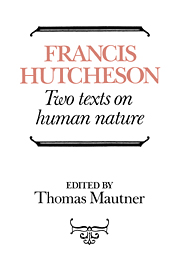The intellectual environment
Published online by Cambridge University Press: 09 October 2009
Summary
The rejection of the view that all our actions are ultimately self-interested was perhaps what mattered most to Hutcheson. His position can be better understood once we understand why it could be so significant. To this end, a view of the intellectual landscape in which he was situated will help. First to be considered are the religious and moral notions that were inculcated in most people early in life.
Man's natural corruption
When considering the way people are and the things they do – human characters and actions – some will seem to us indifferent: neither good nor bad. But as for the rest, we inevitably divide them. We approve of some, disapprove of some; some are admired, some despised.
There have been times and places when this apparently natural way of thinking has met powerful opposition. The division into good and bad is rejected. In its place comes a different doctrine, one which denies that any human character or action can be good. Human nature is essentially flawed. The basic contrast is no longer that between the good and the bad. The only distinction that can have any application in real life is that between two ways in which the bad appears. The bad may appear in disguise, masquerading as something good; or it may appear undisguised.
This view seems at first sight to be strongly supported by the facts.
- Type
- Chapter
- Information
- Hutcheson: Two Texts on Human Nature , pp. 8 - 30Publisher: Cambridge University PressPrint publication year: 1993



